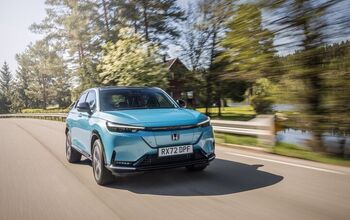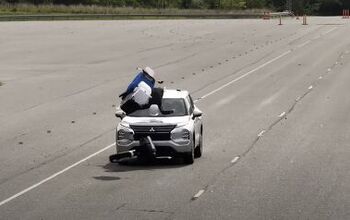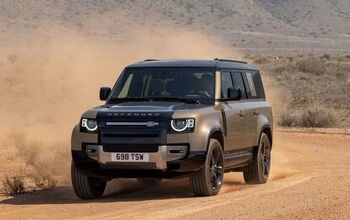Honda Speaks About Near Future, EV Plans

Honda has sent us a brief on its hopes and plans for the near future.
Not surprisingly, there's a fair amount of optimism and some gestures toward EV plans.
Of course, corporations are going to put their best foot forward in these types of media briefs, so you can take things with a grain of salt (or maybe Jimmy Buffett's lost shaker), but here are the highlights:
- As of the end of the 2023 fiscal year that ended on March 31, Honda has cut fixed costs by more than 10 percent since fiscal year 2019. The company also says its break-even point based on the percentage of production capacity being utilized is down about 10 percent, again since fiscal year 2019. Honda also says it's continuing to aim to reach a goal of a 7 percent return on sales by fiscal year 2026.
- Honda is touting increased relationships with semiconductor manufacturers, including Taiwan Semiconductor Manufacturing Company Limited.
- Like many OEMs, Honda has ambitious EV goals -- goals we've generally been skeptical about. In this case, Honda wants to be 100 percent EV and fuel-cell EV by 2040. To that end, the company is making vague promises about working on procuring and developing batteries, as well as procuring materials for battery-making from recyclers.
- Honda has plans for a mid- to large-size electric vehicle to debut for sale in North America in 2025, based on a dedicated platform. An EV based on the N-ONE will go on sale in Japan in 2025, with two small EVs following in 2026. One will be an SUV.
- The company has a focus on software and plans to double the number of hires already planned and will add an executive to be in charge of user experience.
- Finally, the company is sinking 100 billion yen into the research of "next-generation mobility." The company doesn't say what that is, but we suspect autonomous vehicles are involved somehow.
There's more. Honda is focusing on zero traffic collision fatalities and zero environmental impact, and it plans to aim to accomplish those goals via carbon neutrality, using vehicles as an energy source, circulating resources, automated driving and advanced driver-assist systems, and the connected Internet of things.
It's not just electric cars the company has set its sights on. Honda claims to be launching 10 electric motorcycles globally by 2025. The ultimate goal is electric motorcycle sales of 3.5 million units, or 15 percent of overall sales, by 2030. That includes the launch of the EM1e, an electric scooter with a swappable battery, in Indonesia, Europe, and Japan before the end of this year.
Swappable batteries aren't the only approach -- the company is researching other power sources for electric motorcycles.
Back to cars: Honda is going to launch the e:NS2 and e:NP2 EVs in China early next year, along with models based on the e:N SUV xu concept that will launch later in the year. Overall, the company is aiming for 10 new EVs in the Chinese market by 2027, with 100 percent electrification by 2035.
The North American market will see the Honda Prologue and Acura ZDX launch in 2024 next year, along with the aforementioned EV on a dedicated platform. Japan will also get a mini-EV based on the N-VAN for commercial use in the first half of next year.
Honda is planning to dive deeper into the charging business too, using the power supply provided by EVs. There will also be some sort of partnership with an existing company that does public charging so that Honda can better provide public charging options to its EV customers.
Honda is, as we know, working with GM on Ultium batteries for the North American market, and it's working with suppliers Contemporary Amperex Technology Co., Limited in China and Envision AESC in Japan.
That's for the short term -- Honda will work on creating semi-solid-state and all-solid-state batteries in-house further down the road. It's also going to work with GS Yuasa International on high-capacity, high-output liquid lithium-ion batteries. Honda is projecting that it will be bringing all-solid-state batteries to the market by the second half of this decade.
The company will work with SES AI Corporation on semi-solid-state batteries.
Honda is going to work with Hanwa Co., Ltd on procuring materials such as nickel, cobalt, and lithium. The recyclers Honda will work with for materials include Ascend Elements, Inc., Cirba Solutions, and POSCO Holdings, Inc.
EVs will be built right here in the States, with the Marysville and East Liberty plants in Ohio being retooled along with the Anna Engine plant, which is also in Ohio.
Speaking of plants, Honda claims that the Saitama plant in Japan will be carbon neutral by the end of fiscal year 2026. In addition to reducing carbon emissions from its plants, the company is going to use automation and artificial intelligence as part of its plans to both adjust to how the future workforce changes, and to be able to shift to building EVs quickly.
Finally, you might see a new Honda tagline -- "How We Move You" -- working with "Create, Transcend, Augment" and the current "Power of Dreams" slogan.
That's a lot, and I spent a lot of time translating corpo-speak while writing this post. We are skeptical of most automaker's timelines when it comes to full electrification, for a lot of reasons (tech developing slower than planned, infrastructure issues, some remaining demand for ICEs (maybe in limited applications like sports cars), an ever-shifting regulatory environment, and more). So we're skeptical here, too. That doesn't mean we're cynical --Honda and other automakers certainly could hit their targets -- just that it won't be easy.
That said, Honda has laid out its strategy for electrification and other key aspects of its business for the next few years. Your author won't predict here if the company will be successful or not, but the company does at least have a fairly clear road map forward.
[Image: Honda]
Become a TTAC insider. Get the latest news, features, TTAC takes, and everything else that gets to the truth about cars first by subscribing to our newsletter.

Tim Healey grew up around the auto-parts business and has always had a love for cars — his parents joke his first word was “‘Vette”. Despite this, he wanted to pursue a career in sports writing but he ended up falling semi-accidentally into the automotive-journalism industry, first at Consumer Guide Automotive and later at Web2Carz.com. He also worked as an industry analyst at Mintel Group and freelanced for About.com, CarFax, Vehix.com, High Gear Media, Torque News, FutureCar.com, Cars.com, among others, and of course Vertical Scope sites such as AutoGuide.com, Off-Road.com, and HybridCars.com. He’s an urbanite and as such, doesn’t need a daily driver, but if he had one, it would be compact, sporty, and have a manual transmission.
More by Tim Healey
Latest Car Reviews
Read moreLatest Product Reviews
Read moreRecent Comments
- Bd2 Lexus is just a higher trim package Toyota. ^^
- Tassos ONLY consider CIvics or Corollas, in their segment. NO DAMNED Hyundais, Kias, Nissans or esp Mitsus. Not even a Pretend-BMW Mazda. They may look cute but they SUCK.I always recommend Corollas to friends of mine who are not auto enthusiasts, even tho I never owed one, and owned a Civic Hatch 5 speed 1992 for 25 years. MANY follow my advice and are VERY happy. ALmost all are women.friends who believe they are auto enthusiasts would not listen to me anyway, and would never buy a Toyota. They are damned fools, on both counts.
- Tassos since Oct 2016 I drive a 2007 E320 Bluetec and since April 2017 also a 2008 E320 Bluetec.Now I am in my summer palace deep in the Eurozone until end October and drive the 2008.Changing the considerable oils (10 quarts synthetic) twice cost me 80 and 70 euros. Same changes in the US on the 2007 cost me $219 at the dealers and $120 at Firestone.Changing the air filter cost 30 Euros, with labor, and there are two such filters (engine and cabin), and changing the fuel filter only 50 euros, while in the US they asked for... $400. You can safely bet I declined and told them what to do with their gold-plated filter. And when I changed it in Europe, I looked at the old one and it was clean as a whistle.A set of Continentals tires, installed etc, 300 EurosI can't remember anything else for the 2008. For the 2007, a brand new set of manual rec'd tires at Discount Tire with free rotations for life used up the $500 allowance the dealer gave me when I bought it (tires only had 5000 miles left on them then)So, as you can see, I spent less than even if I owned a Lexus instead, and probably less than all these poor devils here that brag about their alleged low cost Datsun-Mitsus and Hyundai-Kias.And that's THETRUTHABOUTCARS. My Cars,
- NJRide These are the Q1 Luxury division salesAudi 44,226Acura 30,373BMW 84,475Genesis 14,777Mercedes 66,000Lexus 78,471Infiniti 13,904Volvo 30,000*Tesla (maybe not luxury but relevant): 125,000?Lincoln 24,894Cadillac 35,451So Cadillac is now stuck as a second-tier player with names like Volvo. Even German 3rd wheel Audi is outselling them. Where to gain sales?Surprisingly a decline of Tesla could boost Cadillac EVs. Tesla sort of is now in the old Buick-Mercury upper middle of the market. If lets say the market stays the same, but another 15-20% leave Tesla I could see some going for a Caddy EV or hybrid, but is the division ready to meet them?In terms of the mainstream luxury brands, Lexus is probably a better benchmark than BMW. Lexus is basically doing a modern interpretation of what Cadillac/upscale Olds/Buick used to completely dominate. But Lexus' only downfall is the lack of emotion, something Cadillac at least used to be good at. The Escalade still has far more styling and brand ID than most of Lexus. So match Lexus' quality but out-do them on comfort and styling. Yes a lot of Lexus buyers may be Toyota or import loyal but there are a lot who are former GM buyers who would "come home" for a better product.In fact, that by and large is the Big 3's problem. In the 80s and 90s they would try to win back "import intenders" and this at least slowed the market share erosion. I feel like around 2000 they gave this up and resorted to a ton of gimmicks before the bankruptcies. So they have dropped from 66% to 37% of the market in a quarter century. Sure they have scaled down their presence and for the last 14 years preserved profit. But in the largest, most prosperous market in the world they are not leading. I mean who would think the Koreans could take almost 10% of the market? But they did because they built and structured products people wanted. (I also think the excess reliance on overseas assembly by the Big 3 hurts them vs more import brands building in US). But the domestics should really be at 60% of their home market and the fact that they are not speaks volumes. Cadillac should not be losing 2-1 to Lexus and BMW.
- Tassos Not my favorite Eldorados. Too much cowbell (fins), the gauges look poor for such an expensive car, the interior has too many shiny bits but does not scream "flagship luxury", and the white on red leather or whatever is rather loud for this car, while it might work in a Corvette. But do not despair, a couple more years and the exterior designs (at least) will sober up, the cowbells will be more discreet and the long, low and wide 60s designs are not far away. If only the interiors would be fit for the price point, and especially a few acres of real wood that also looked real.


































Comments
Join the conversation
So all Hondas will be completely soulless lumps by 2040, just like the new “Accord.”
Got it!
Too little. Too late.